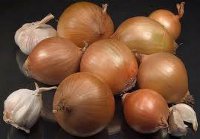Bitter benefits of garlic and onion
 If you eat at least 4 grams of garlic a day, your blood pressure lowers. A daily intake of 1 clove of fresh garlic for 16 weeks lowers cholesterol by 21%. The benefits of onion and garlic are well known. Yet, we don't eat as much of these products as we used to. It is time we remember about them.
If you eat at least 4 grams of garlic a day, your blood pressure lowers. A daily intake of 1 clove of fresh garlic for 16 weeks lowers cholesterol by 21%. The benefits of onion and garlic are well known. Yet, we don't eat as much of these products as we used to. It is time we remember about them.

In his book "Hypertension - 80% without drugs" the MN Sergey Aleshin wrote about garlic and onions: "They contain a large amount of sulfur-containing antioxidants, which protect the body against free radicals damage."
Many cannot eat this product because of its pungent odor, which is caused by a particular substance - allicin - that has a strong antibacterial effect. Therefore, many drugs are produced by drying garlic. While manufacturers claim that its valuable qualities are not lost in the process, some researchers believe that such drugs have only a minimal protective effect. Only fresh garlic grown on good soil is valuable.
As for onions, they have all the healing properties of garlic, only to a lesser extent, so it should be eaten in larger amounts - an average of 50 grams per day. Aleshin: "I will note that onions, in addition, contain quercetin that protects the cardiovascular system from free radical damage."
Superfoods for hypertension
These are, above all, natural unprocessed or slightly processed cereals and legumes with a high content of calcium, magnesium, potassium, B vitamins and fiber. According to an American study, women who consume whole foods, decrease their risk of heart diseases by 25% compared to women who eat processed food. Replacement of white polished rice with whole grain products or beans for 16 weeks results in a decrease in blood sugar by 24%.
Indeed, the difference in the nutritional value of such products is high. For example, the calcium content in white wheat bread is 20 mg, whole grain breads - 43mg, boiled white rice - 2 mg, cooked brown rice - 10mg. The content of Mg is 14/74 and 5 / 43 mg, respectively, potassium - 93 / 234 and 10/43 mg, vitamin E - 1.68 micrograms in white bread and 3.8 in the whole grain bread, and 0.030 in white rice and 0.216 in brown rice.
At the end of the last century nuts have been fully rehabilitated as previously doctors did not recommend them due to high fat content. Studies have shown that those who ate nuts 5 times a week had 50% lower risk of coronary heart disease. The fat contained in nuts is predominately unsaturated and contains first class protein, fiber and phytosterols that block the absorption of cholesterol in the intestines. Nuts are also rich in the amino acid arginine that forms nitric oxide that expands blood vessels and prevents blood clotting.
Although in the early twentieth century it was considered that milk consumption leads to lower blood pressure, in the last 25 years there was a real hysteria about dairy products. They were seen as the main source of saturated fat intake and, consequently, as a culprit of high cholesterol. Recent research has not only rehabilitated the milk, but also proved that people who replaced the fruit and vegetable diet with daily consumption of 2 or more glasses of milk have shown double increase in the antihypertensive effect, as well as lowered risk of thromboembolic stroke and metabolic syndrome.
Scottish researchers who conducted a 25-year observation of 5,765 men used milk with high fat content, and did not reveal any connection between this fact and mortality from various causes, including coronary heart diseases. The advantage of fat-free products is only the fact that they can reduce caloric intake, which is important for people who are overweight.
Healing properties of milk are explained by high content of calcium, magnesium and potassium as well as low sodium content. Milk also contains protein casein, which is capable of lowering the level of the strongest factor of atherosclerotic lipoprotein A. Aleshin proposes to take into account the fact that some people are intolerant to milk, so they should not use this method of prevention.
- This shows that certain foods can reduce blood pressure preempt the development of the disease.
- Elizaveta Vasilyeva
- Medpulse
Subscribe to Pravda.Ru Telegram channel, Facebook, RSS!


